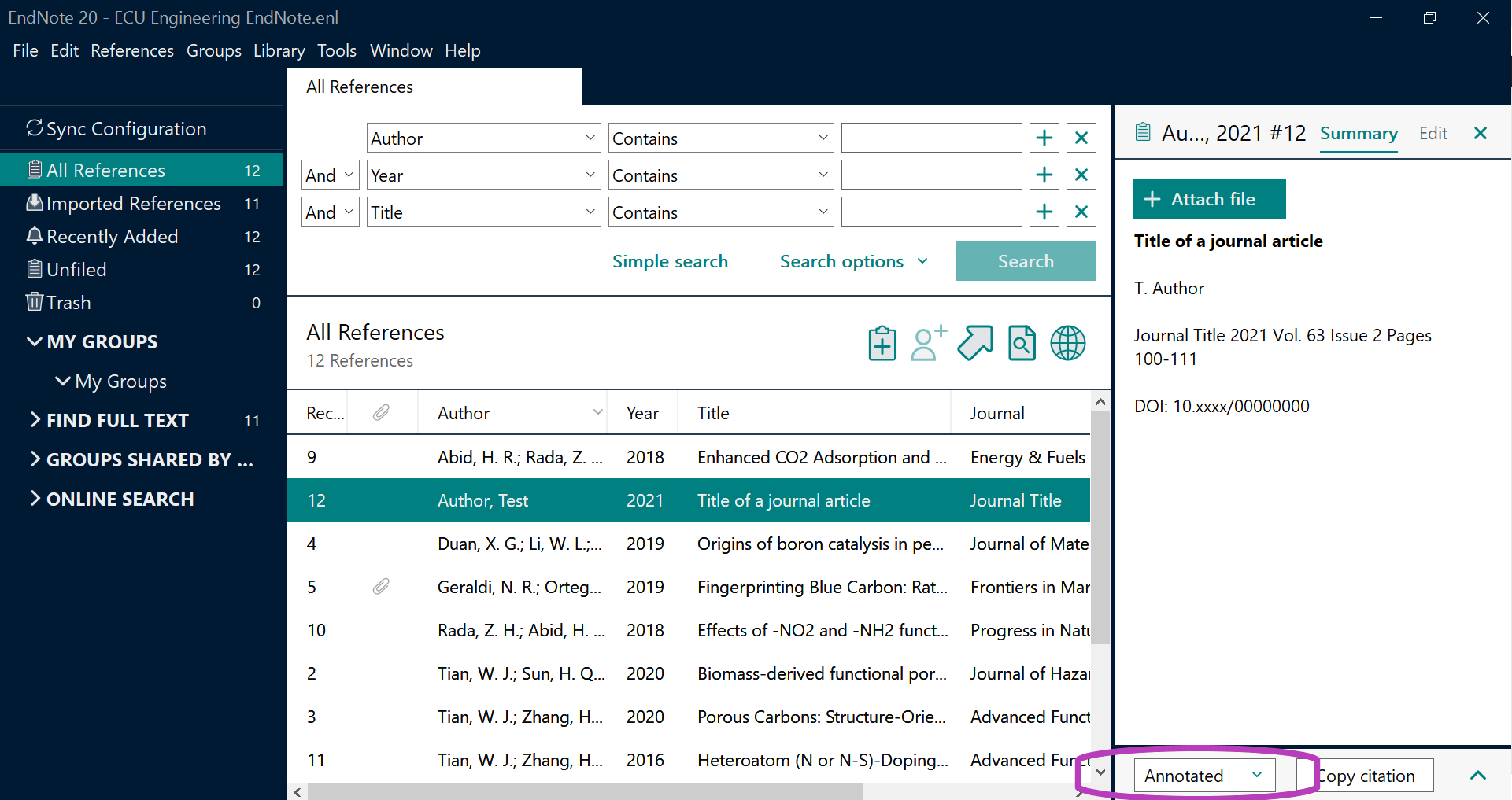Referencing Output Styles
Select an output style in the menu bar under Tools > Output Styles, or using the output style drop-down menu at the bottom of your EndNote library's reference summary panel. This drop-down menu is circled in the image below.

The default style is Annotated, and a number of common styles will be available under the drop-down menu.
The APA 7th style of referencing is used in most courses across ECU. However, some disciplines may use a different style, e.g. AGLC4 for Law. Researchers are also required to use various styles in publishing, as determined by the journal. Check your unit outline or the author guidelines for publishing to see what style you should be using.
EndNote comes pre-loaded with many of the most popular styles including APA, Chicago, MLA, and Vancouver, as well as a number of styles for specific journals. APA 7th is available on student computers (choose 'Select Another Style...' to find it). Staff and those who downloaded EndNote before mid-December 2019 might need to download APA 7th.
Downloading a Style
Some additional styles that are not already available in EndNote, or updates to current styles, can be downloaded from the EndNote website.
e.g. Strength and Conditioning Journal style. Installing this Referencing Output Style file will allow EndNote to format your references properly for submission to the Strength and Conditioning Journal. To download the style, follow the instructions at the linked site.
If you are looking for a specific style required by a journal, in some cases the journal will provided a downloadable EndNote style, or the style will be available through external organisations. For example, the Journal of Australian Strength and Conditioning provides a downloadable style in their author guidelines, and the AGPS adaption of Harvard style is available to download through the University of Queensland.
As long as the styles download as .ens files, you can add them to EndNote using the installation instructions below. For more help, search for 'Output styles' at EndNote's support site:
Installing a New Style
To install a style, you need to:
- download the style
- find the output style file (.ens),
- locate the EndNote Styles folder, and
- move the .ens file to your EndNote Styles folder.
-
Download the style
See instructions and links above to download the style you want to use.
-
Find the output style file
This file will have the file extension .ens and will probably be located in your Downloads folder. If you can't find it there, check your browser downloads page to see where it might have been saved.
-
Locate the Styles folder
In EndNote, go to Edit > Preferences... and select Folder Locations as shown below.
The file path for the Style Folder is located at the top of the box. Use the location information to navigate in your file explorer to this location on your hard drive.
If there is currently no Style folder where it should be, create the folder using the same spelling and punctuation shown in the Folder Location path.
If you want to change the location of your Style folder, you can do so by clicking Select Folder and choosing a better location. It does not matter where your Style folder is kept, as long as it is available whenever you are using EndNote.
-
Move your .ens file to the Styles folder
Drag or copy your .ens style file into this Styles folder.
Once your new style is copied into this folder, the style should appear in your Style Manager immediately. It will also be available in Word if you are using the Cite While You Write add-in.
AGLC (Australian Guide to Legal Citation) and EndNote
The University of Technology Sydney (UTS) has created an output style for legal referencing using EndNote that conforms with the requirements of the Australian Guide to Legal Citation (4th edition).
There are two files to download and install from the UTS EndNote Law: Install webpage:
- Legal Reference Types
- AGLC4 (UTS) style
Follow the download and installation instructions on the webpage.
UTS also provides a guide explaining which EndNote fields to use when citing legal materials: EndNote Law: Citations.
- To apply this style in a Word document, under the 'EndNote' tab, change the 'Style' to AGLC4 (UTS).
- You will need to insert a footnote via the 'References' tab, and then use the 'EndNote' tab to insert the citation in the footnote.
- Add a pinpoint by clicking on 'Edit & Manage Citation(s)' in the menu bar, and entering the pinpoint in the box labeled 'Pages'.
-
EndNote 20 for LawSteps to installing and using EndNote 20 with the AGLC4 legal citation style
Troubleshooting: Undefined Reference Type
When you change from one style to another, the following error might appear in your reference list:
[Record #___ is using a reference type undefined in this output style.]
Your reference information is still there. This just means that the person who created the style file you used did not include every reference type that was available in your original style file.
One common example is when moving from APA 6th to APA 7th output styles. In APA 6th style, users would choose the reference type Government Document for some types of reports. Due to simplifications in APA 7th style, the reference type Report is sufficient, so no style was specified for Government Document.
The fix:
Change the reference type to one that is fully defined in your new style. In our example, changing from Government Document to Report in APA 7th style will generate a full reference.
If you have a large number of these references, you can change them all at once using the Find and Replace function. Please back up your library before attempting this (File > Compressed Library) as you can't revert the changes if anything goes wrong. Follow the link below for instructions.
